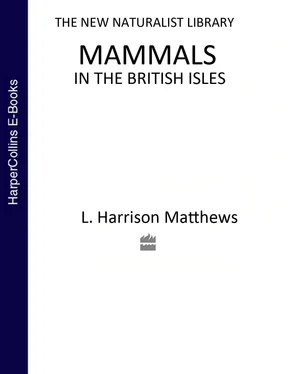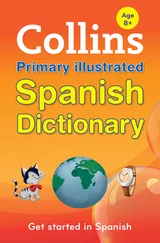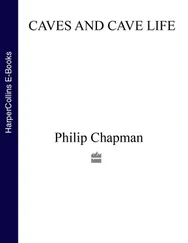The well-known badger, Meles meles , grey above and black below, with a fore-and-aft black streak over eye and ear on each side of the white head, is found throughout the mainland of the British Isles and on some of the islands, and is common in many parts. It is a comparatively large animal – weights of over 35 pounds have been recorded – and is so widely spread because it is adaptable to many different habitats, has discreetly retiring habits, and is omnivorous, eating anything from earthworms to rabbits and from fruit, bulbs, and nuts to corn and grass. It comes out to forage at night, remaining underground in its set by day.
The otter, Lutra lutra , on the other hand is restricted in habitat to the neighbourhood of water, and, though formerly found throughout the British Isles and the off-lying islands, is consequently much less common than the badger; since about 1950 it has declined greatly in numbers over most of mainland Great Britain, but it is still plentiful in western Scotland, Ireland, much of Wales and south west England. The aquatic habit of the otter is shown by its webbed feet and broad snout with long tactile whiskers. The fur is brown all over, lighter on the throat, and the tail is long and tapering. The diet of the otter consists mainly of fish, freshwater or marine, for in the west of Scotland it is as much an inhabitant of the sea shore as of fresh waters.
Family Felidae
The wild cat, Felis silvestris, somewhat larger than most domestic cats, is a tabby with dark cross stripes on a grey background, and bushy tail ending in a rounded, not pointed, black tip. It has long been extinct in most of Great Britain and is now found mainly in the highlands of Scotland where it is extending into its former range; it was never native to Ireland. Its food includes rabbits, hares, rodents, and birds. It has hybridised much with feral domestic cats – domestic cats both feral and tame are probably the most destructive of all predators to the small mammals and birds of our fauna.
ORDER PINNIPEDIA
The seals are only marginally part of our fauna, for they are confined to the waters off the coast and to the sea shore from which they come a short way onto land only in remote undisturbed islands. They are, however, animals of particular interest to zoologists, and of unusual endearment to the public in general. Two species live and breed on British coasts; five others are merely accidental vagrants from northern seas, and thus form no regular part of our fauna.
Family Phocidae
The common seal, Phoca vitulina , and the grey seal, Halichoerus grypus, are not easy to tell apart when in the water, unless very close to the viewer. The coat colour of both species varies greatly; the basic pattern is of dark spots on a grey background, the spots tending to be smaller in the common seal, but no two individuals are exactly alike. Bull common seals reach a length of two metres overall, cows about 20 cm less, whereas bull grey seals reach three metres but the cows some 45 cm to 60 cm less. The snout of the common seal is comparatively short, giving the head a rounded appearance and a ‘dished’ profile; in the grey seal it is long and high, giving a convex profile to the head. Both species can be found on many parts of our coasts, but concentrate in special places to form breeding colonies. The common seal is least likely to be met with on the southern and western coasts of England and Wales; it breeds at several places on the east coast, especially in the Wash, in Orkney and Shetland, on the west of Scotland and the islands, and the east of northern Ireland. On the east coast of England the main breeding colony of the grey seal is at the Farne islands; in Scotland it abounds in Orkney and Shetland and many islands of the west. There are also breeding colonies on the coasts of Wales, Cornwall, and much of Ireland. The common seal prefers shallow waters with sand and mudbanks and is often found in estuaries, whereas the grey seal lives in deeper waters off rocky coasts. Both species come ashore to give birth, the young of the grey seal remaining on or above the beach for about their first three weeks, but those of the common seal, born on sand or mudbanks covered at high tide, swim with their mothers from the first.
ORDER PERISSODACTYLA
Family Equidae
Wild horses have been extinct in the British Isles for about 10,000 years, but half-wild breeds derived from introduced domestic horses exist in several districts of extensive unenclosed land.
ORDER ARTIODACTYLA
Family Suidae
The wild boar, Sus scrofa , has been extinct in Great Britain for some 300 years. Although its domesticated descendants have played an important part in the rural economy of Ireland it was never indigenous there.
Family Cervidae
Stags of the largest of our two native species of deer, the red deer Cervus elaphus , stand up to about four feet at the withers, hinds about six inches less. The coat colour varies greatly; in general it is red-brown in summer, grey-brown in winter, with a white patch on the rump. Calves at birth are reddish-brown with white spots, but lose the spots at their first moult at the age of about two months. Horns, now generally called antlers, a term originally meaning the branches or tines, are carried only by stags. They are dropped from the pedicles, from which they grow on the forehead, in spring or summer, whereupon new ones at once start growing and are complete by the autumn. The red deer, formerly present throughout the British Isles, remains as a truly wild animal only in Scotland, the Lake district, on Exmoor and the Quantock Hills, and in south-west Ireland; elsewhere feral deer, often derived from escaped park animals, are present in many places. In Scotland the deer are animals of the hill, but in lowland England they are more generally inhabitants of woodland where they reach greater size and the stags bear larger antlers.
The sika deer, C. nippon , smaller than the red deer but similar in build, was introduced from the Far East in the second half of the nineteenth century, and feral populations have become established in a number of places in the British Isles. The coat is red with light spots in summer, darker and unspotted in winter; the rump patch and tail are white except for a narrow black line on the latter. The antlers of the stags are smaller and have fewer tines than those of the red deer, and lack a bez tine between the brow and trez tines. Sika deer inhabit woodlands from which they come out to graze from dusk to dawn. They hybridize freely with red deer where the ranges of the two species overlap.
The fallow deer, Dama dama , is another introduced species, but has been adopted into our fauna for a much longer time – probably almost a thousand years. It has for long been a favourite ornament in parks from which it has escaped so that feral populations are widespread in England, Wales and Ireland, and are found in some parts of Scotland; those in Epping and the New Forests probably represent the early stock. Bucks stand about three feet high at the withers, does a few inches less; the antlers of the bucks are usually handsomely palmated. The colour varies greatly but is light with spots in summer, much darker and generally without spots in the winter. The border of the white rump patch is black, as is the upper surface of the tail.
The roe deer, Capreolus capreolus , is a true native of Great Britain but not of Ireland. It is plentiful in Scotland and northern England, but has been introduced into southern England, and into East Anglia where it was exterminated some two hundred years ago. It is a small deer, barely two feet six inches at the withers, with no visible tail. The colour is tawny red, the muzzle black and the chin white; in the darker brown winter coat two white patches appear on the throat. The antlers of the buck are short spikes each with one forwardly directed tine at the base and a backwardly directed one at the top. Roe live in woodlands, which they leave to browse on bushes at dawn and dusk.
Читать дальше












